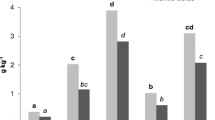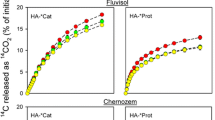Abstract
The residual effects of adding 40 t ha−1 sewage sludge (SL) to a degraded soil cropped with barley were investigated after 9 and 36 months in a field experiment under semiarid conditions. The principal soil properties were apparently still affected by SL amendment 9 months after application but the effects disappeared after 36 months. With respect to control soil humic acids (HAs), the SL-HA was characterized by higher contents of S- and N-containing groups, smaller contents of acidic groups, a prevalent aliphaticity, extended molecular heterogeneity, and smaller degrees of aromatic polycondensation and humification. Amendment with SL caused an increase in N, H, S and aliphaticity contents and a decrease in C/N ratios and O and acidic functional group contents in soil HAs isolated 9 months after SL application. These effects tended to decrease after 36 months, most probably because the slightly humified SL-HA was mineralised over time through extended microbial oxidation, while only the most recalcitrant components such as S-containing and aromatic structures were partially accumulated by incorporation into soil HA. Microbial biomass, basal respiration, metabolic quotient and enzymatic activities increased in soil 9 months after SL application, possibly because of increased soil microbial metabolism and enhanced mineralisation processes. After 36 months these properties returned to values similar to those of the unamended soil, presumably due to the loss of energy sources.




Similar content being viewed by others
References
Anderson JPE (1982) Soil respiration. In: Page AL, Miller RM, Keeney DR (eds) Methods of soil analysis. Part 2. Chemical and microbiological properties, 2nd edn. (Agronomy monograph no. 9) ASA, CSSA, SSSA, Madison, Wis., pp 831–871
Bandick AK, Dick RP (1999) Field management effects on soil enzyme activities. Soil Biol Biochem 31:1471–1479
Barbarick KA, Ippolito JA, Westfall DG (1997) Sewage biosolids cumulative effects on extractable-soil and grain elemental concentrations. J Environ Qual 26:1696–1702
BOE (1990) Real decreto 1310/1990, de 29 de octubre, por el que se regula la utilización de los lodos de depuración en el sector agrario
Bolton HJ, Fredrickson JK, Elliot LF (1993) Microbial ecology of the rhizosphere. In: Metting B (ed) Soil microbial ecology. Dekker, New York, pp 27–63
Bouwman AF (1990) Exchange of greenhouse gases between terrestrial ecosystems and the atmosphere. In: Bouwman AF (ed) Soils and the greenhouse effect. Wiley, Chichester, pp 61–127
Brookes PC, McGrath SP (1984) Effects of metal toxicity on the size of the microbial biomass. J Soil Sci 35:341–346
Bureau RG (1982) Lead. In: Page AL, Miller RM, Keeney DR (eds) Methods of soil analysis. Part 2. Chemical and microbiological properties, 2nd edn. (Agronomy monograph no. 9) ASA, CSSA, SSSA, Madison, Wis., pp 347–365
Burns RG (1982) Enzyme activity in soil: location and possible role in microbial ecology. Soil Biol Biochem 14:423–427
Burriel F, Hernando V (1950) El fósforo en los suelos españoles. V. Nuevo método para determinar el fósforo asimilable en los suelos. Anal Edaf Agrobiol 9:611–622
Carpenter-Boggs L, Kennedy AC, Reganold JP (2000) Organic and biodynamic management: effects on soil biology. Soil Sci Soc Am J 64:1651–1659
Chen Y, Senesi N, Schnitzer M (1977) Information provided on humic substances by E 4/ E 6 ratios. Soil Sci Soc Am J 41:352–358
Clapp CE, Stark SA, Clay DE, Larson WE (1986) Sewage sludge organic matter and soil properties. In: Chen Y, Avnimelech Y (eds) The role of organic matter in modern agriculture. Nijhoff, Dordrecht, pp 88–97
Clapp CE, Hayes MHB, Senesi N, Bloom PR, Jardine PM (2001) Humic substances and chemical contaminants. ASA, CSSA, SSSA, Madison, Wis.
Dahlin S, Witter E, Martensson AM, Turner A, Bââth E (1997) Where’s the limit? Changes in the microbiological properties of agricultural soils at low levels of metal contamination. Soil Biol Biochem 29:1405–1415
Dick WA, Tabatabai MA (1993) Potential uses of soil enzymes. In: Metting B (ed) Soil microbial ecology. Dekker, New York, pp 95–127
Eivazi F, Zakaria A (1993) β-Glucosidase activity in soils amended with sewage sludge. Agric Ecosyst Environ 43:155–161
FAO-ISSS (1998) World reference base for soil resources. Food and Agriculture Organization of the United Nations, Rome
García C, Hernández T (1996) Influence of salinity on the biological and biochemical activity of calciorthid soil. Plant Soil 178:255–263
García C, Hernández T, Costa F, Ceccanti B, Masciandaro G (1993) The dehydrogenase activity of soil as an ecological marker in processes of perturbed system regeneration. In: Gallardo-Lancho J (ed) Proceedings of the XIth International Symposium of Environmental Biochemistry, Salamanca, Spain. pp 89–100
García C, Hernández T, Costa F (1994a) Microbial activity in soils under mediterranean environmental conditions. Soil Biol Biochem 26:1185–1191
García C, Hernández T, Costa F, Ceccanti B (1994b) Biochemical parameters in soil regenerated by addition of organic wastes. Waste Manage Res 12:457–466
García-Gil JC, Plaza C, Soler-Rovira P, Polo A (2000) Long-term effects of municipal solid waste compost application on soil enzyme activities and microbial biomass. Soil Biol Biochem 32:1907–1913
Hall JE (1995) Sewage sludge production, treatment and disposal in the European Union. J CIWEM 9:335–343
Hinds A, Lowe LE (1980) Ammonium-N determination. Soil nitrogen. Berthelot reaction. Soil Sci Plant Anal 11:469–475
Hooda PS, McNulty D, Alloway BJ, Aitken MN (1997) Plant availability of heavy metals in soils previously amended with applications of sewage sludge. J Sci Food Agric 73:446–454
Insam H, Domsch KH (1988) Relationship between soil organic carbon and microbial biomass on chronosequences of reclamation sites. Microbial Ecol 15:177–188
Johansson M, Stenberg B, Torstensson L (1999) Microbiological and chemical changes in two arable soils after long-term sludge amendments. Biol Fertil Soils 30:160–167
Kabata-Pendias A (2001) Trace elements in soils and plants, 3rd edn. CRC, Boca Ratón, Fla.
Keller C, McGrath SP, Dunham SJ (2002) Trace metal leaching through a soil-grassland system after sewage sludge application. J Environ Qual 31:1550–1560
Landi L, Renella G, Moreno JL, Falchini L, Nannipieri P (2000) Influence of cadmium on the metabolic quotient, l -: d -glutamic acid respiration ratio and enzyme activity: microbial biomass ratio under laboratory conditions. Biol Fertil Soils 32:8–16
Leita L, De Nobili M, Mondini C, Muhlbachova G, Marchiol L, Bragato G, Conti M (1999) Influence of inorganic and organic fertilization on soil microbial biomass, metabolic quotient and heavy metal bioavailability. Biol Fertil Soils 28:371–376
Logan TJ, Lindsay BJ, Goins LE, Ryan JA (1997) Field assessment of sludge metal bioavailability to crops: sludge rate response. J Environ Qual 26:534–550
Lynch JM, Whipps JM (1990) Substrate flow in the rhizosphere. Plant Soil 129:1–10
Masciandaro G, Ceccanti B, García C, (1994) Anaerobic digestion of straw and pig wastewater. II. Optimization of the process. Agrochimica 3:195–203
Midwood AJ, Boutton TW (1998) Soil carbonate decomposition by acid has little effect on the δ13C or organic matter. Soil Biol Biochem 30:1301–1307
Moreno JL, Hernández T, García C (1999) Effects of a cadmium-contaminated sewage sludge compost on dynamics of organic matter and microbial activity in an arid soil. Biol Fertil Soils 28:230–237
Nannipieri P (1994) The potential use of soil enzymes as indicators of productivity, sustainability and pollution. In: Pankhurst CE, Doube BM, Gupta VVSR, Grace PR (eds) Soil biota. Management in sustainable farming systems. CSIRO, East Melbourne, Australia, pp 238–244
Nannipieri P, Ceccanti B, Cervelli S, Matarrese E (1980) Extraction of phosphatase, urease, protease, organic carbon and nitrogen from soil. Soil Sci Soc Am J 44:1011–1016
Nannipieri P, Badalucco L, Landi L, Pietramellara G (1997) Measurement in assessing the risk of chemical to the soil ecosystem. In: Zelikoff JT (ed) Ecotoxicology: responses, biomarkers and risk assessment. SOS, Fair Haven, N.J., pp 94–104
Plaza C, Senesi N, García-Gil JC, Brunetti G, D’Orazio V, Polo A (2002) Effects of pig slurry application on soils and soil humic acids. J Agric Food Chem 50:4867–4874
Rodríguez-Kábana R, Truelove B (1982) Effects of crop rotation and fertilization on catalase activity in a soil of the south-eastern United States. Plant Soil 69:97–104
Rosenberg NJ, Izaurralde RC (2001) Storing carbon in agricultural soils to help head-off a global warming. Climatic Change 51:1–10
Sastre I, Vicente MA, Lobo MC (1996) Influence of the application of sewage sludges on soil microbial activity. Bioresour Technol 57:19–23
Schnitzer M (1982) Organic matter characterization. In: Page AL, Miller RM, Keeney DR (eds) Methods of Soil Analysis. Part 2. Chemical and microbiological properties, 2nd edn. (Agronomy monograph no. 9) ASA, CSSA, SSSA, Madison, Wis., pp 581–594
Senesi N, Miano TM, Provenzano MR, Brunetti G (1991) Characterization, differentiation, and classification of humic substances by fluorescence spectroscopy. Soil Sci 152:259–271
Senesi N, Miano TM, Brunetti G (1996) Humic-like substances in organic amendments and effects on native soil humic substances. In: Piccolo A (ed) Humic substances in terrestrial ecosystems. Elsevier, New York, pp 531–593
Skujins J (1976) Extracellular enzymes in soil. Crit Rev Microbiol 4:383–421
Smith JL, Papendick RI, Bezdicek DF, Lynch JM (1993) Soil organic matter dynamics and crop residue management. In: Metting B (ed) Soil microbial ecology. Dekker, New York, pp 65–95
Soler-Rovira PA, Brunetti G, Polo A, Senesi N (2002) Comparative chemical and spectroscopic characterization of humic acids from sewage sludges and sludge-amended soils. Soil Sci 167:235–245
Sparks DL, Page AL, Helmke PA, Loeppert RH, Soltanpour PN, Tabatabai MA, Johnston CT, Sumner ME (1996) Methods of soil analysis. Part 3. Chemical methods. ASA-CSSA-SSSA, Madison, Wis.
Stevenson FJ (1994) Humus chemistry: genesis, composition, reactions. Wiley-Interscience, New York
Stotzky G (1965) Microbial respiration. In: Black CA (ed) Methods of soil analysis. ASA, CSSA, SSSA, Madison, Wis., pp 1550–1570
Tabatabai MA (1982) Soil enzymes. In: Page AL, Miller RM, Keeney DR (eds) Methods of Soil Analysis. Part 2. Chemical and microbiological properties, 2nd edn. (Agronomy monograph no. 9) ASA, CSSA, SSSA, Madison, Wis., pp 903–915
Tabatabai MA, Bremner JM (1969) Use of p -nitrophenol phosphate in assay of soil phosphatase activity. Soil Biol Biochem 1:301–307
Vance ED, Brookes PC, Jenkinson D (1987) An extraction method for measuring microbial biomass carbon. Soil Biol Biochem 19:703–707
Vulkan R, Mingelgrin U, Ben-Asher J, Frenkel H (2002) Copper and zinc speciation in the solution of a soil-sludge mixture. J Environ Qual 31:193–203
Walkley A, Black IA (1934) An examination of the Degtareff method for determining soil organic matter, and a proposed modification of the chromic acid titration method. Soil Sci 37:29–38
Acknowledgements
This work was conducted in the framework of the Spanish CSIC-Italian CNR Bilateral Research Programme. The authors are grateful to the Consejería de Medio Ambiente del Ayuntamiento de Madrid for its financial support.
Author information
Authors and Affiliations
Corresponding author
Rights and permissions
About this article
Cite this article
García-Gil, J.C., Plaza, C., Senesi, N. et al. Effects of sewage sludge amendment on humic acids and microbiological properties of a semiarid Mediterranean soil. Biol Fertil Soils 39, 320–328 (2004). https://doi.org/10.1007/s00374-003-0709-z
Received:
Accepted:
Published:
Issue Date:
DOI: https://doi.org/10.1007/s00374-003-0709-z




